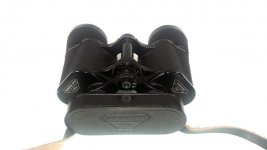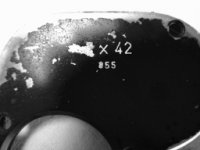I have just bought an old pair of Habicht 7x42 binoculars. I am very impressed with them and like them better than my latest version of the Habicht 8x30 W. This is probably in direct contrast to the opinion of most others and is another example of just how personal a set of binoculars can be. So impressed am I that I will now be selling my much more expensive 8x30 W set of binoculars.
Yes, the 8x30 W provides more neutral, clearer colours but strangely the yellow tinting of the 7x42 does not worry me at all. Yes, the 8x30 W is waterproof but I don't tend to use binoculars in the rain. For my eyes and in practical use, I have found the much reported narrow field of view of the 7x42 and supposed tunnel vision of the 7x42 to be somewhat exaggerated (in other words I am very lucky because it doesn't worry me). I have also found that this narrow field of vision is compensated for by the increased depth of focus found with these binoculars and the great pointing ability of these 7x42's. These properties I value more than a wide field of view. As well, the view through them is spectacularly sharp and is present for the majority of the view (at a guess probably about 80% and much better than the 8x30 W set) and I find this makes them very relaxing to use. Because they are not waterproofed (with associated stiffness of the focusing wheel) the speed of focus is fast and smooth and matches that of my Nikon 8x30 EII's. Once again, speed of focus is something I have begun to value more than being waterproof. Supposedly, these 7x42's are also better than the 8x30 W set at dawn and dusk but I haven't compared them in these conditions yet. I haven't found the difference in magnification between the 7 and 8 times to be significant. Strangely, I find the difference between 8 and 8.5 (found in my Swift 804 binoculars) magnification to be more significant.
To sum up, the properties that I treasure most are excellent clarity (first and foremost), good depth of focus, and fast speed of focusing. Colour cast, wide field of view, and waterproofing, whilst nice to have are further down the list of priorities for me.
My question - I am amazed at the view though these old 7x42 binoculars but how old are they? As seen in the below photo, the serial number appears to be 1716169. Is anyone able to give me an estimate of the year of manufacture?

Yes, the 8x30 W provides more neutral, clearer colours but strangely the yellow tinting of the 7x42 does not worry me at all. Yes, the 8x30 W is waterproof but I don't tend to use binoculars in the rain. For my eyes and in practical use, I have found the much reported narrow field of view of the 7x42 and supposed tunnel vision of the 7x42 to be somewhat exaggerated (in other words I am very lucky because it doesn't worry me). I have also found that this narrow field of vision is compensated for by the increased depth of focus found with these binoculars and the great pointing ability of these 7x42's. These properties I value more than a wide field of view. As well, the view through them is spectacularly sharp and is present for the majority of the view (at a guess probably about 80% and much better than the 8x30 W set) and I find this makes them very relaxing to use. Because they are not waterproofed (with associated stiffness of the focusing wheel) the speed of focus is fast and smooth and matches that of my Nikon 8x30 EII's. Once again, speed of focus is something I have begun to value more than being waterproof. Supposedly, these 7x42's are also better than the 8x30 W set at dawn and dusk but I haven't compared them in these conditions yet. I haven't found the difference in magnification between the 7 and 8 times to be significant. Strangely, I find the difference between 8 and 8.5 (found in my Swift 804 binoculars) magnification to be more significant.
To sum up, the properties that I treasure most are excellent clarity (first and foremost), good depth of focus, and fast speed of focusing. Colour cast, wide field of view, and waterproofing, whilst nice to have are further down the list of priorities for me.
My question - I am amazed at the view though these old 7x42 binoculars but how old are they? As seen in the below photo, the serial number appears to be 1716169. Is anyone able to give me an estimate of the year of manufacture?

Last edited:






